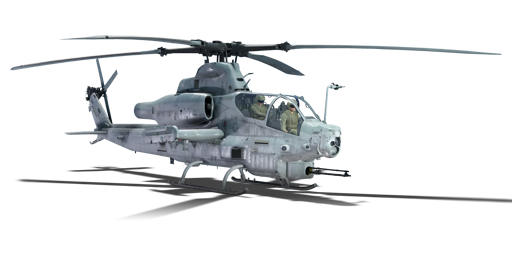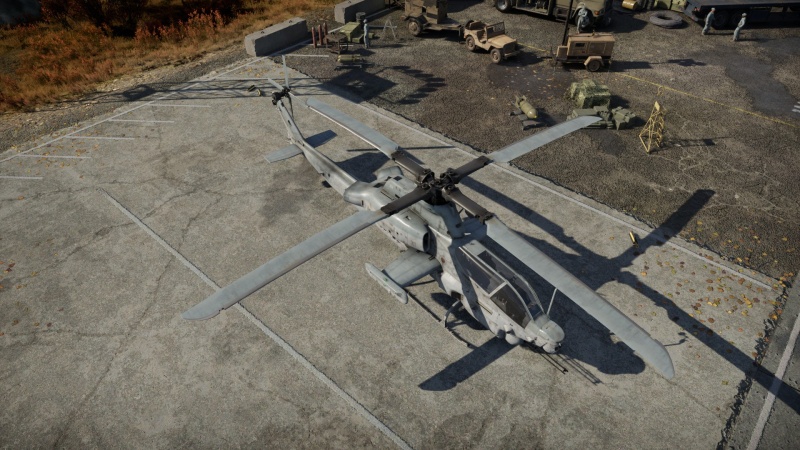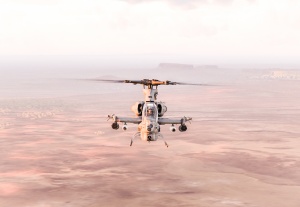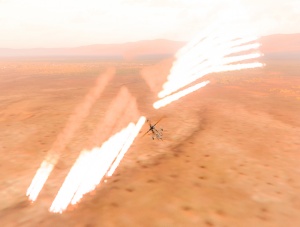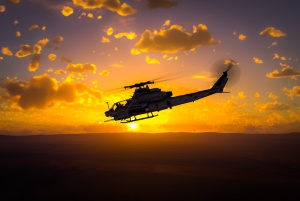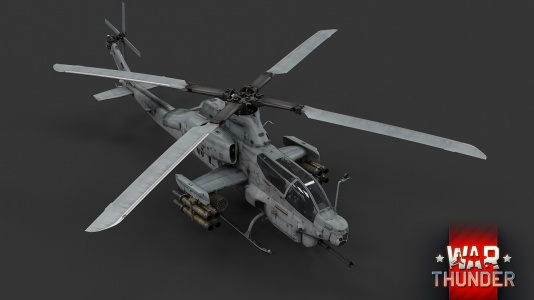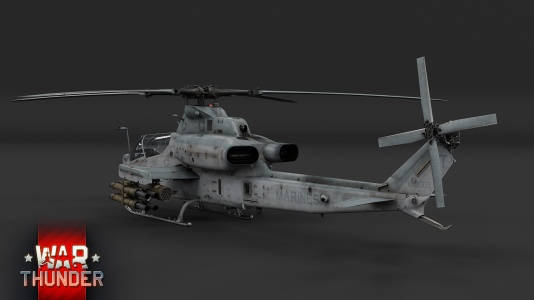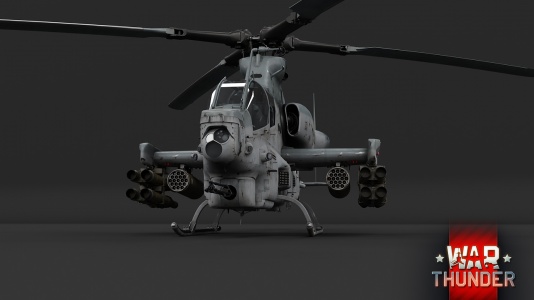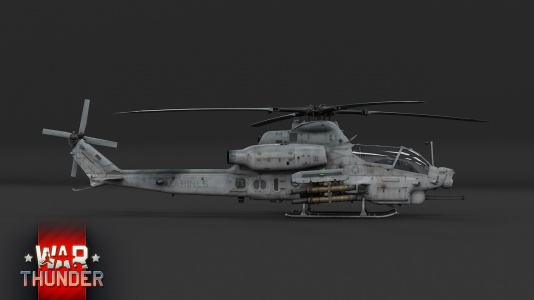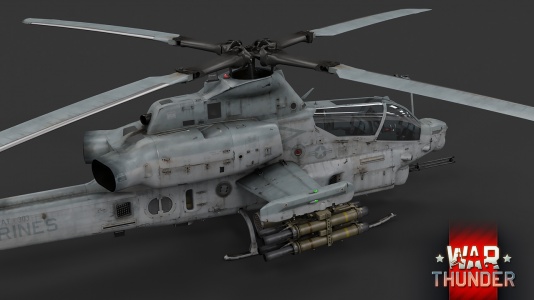Difference between revisions of "AH-1Z"
(→Armaments: Added ballistic computer table) |
KingDriving (talk | contribs) (→Pros and cons) (Tag: Visual edit) |
||
| Line 164: | Line 164: | ||
* Extremely vulnerable to Radar SPAA and jet aircraft | * Extremely vulnerable to Radar SPAA and jet aircraft | ||
* Lacks passive IRCM countermeasure | * Lacks passive IRCM countermeasure | ||
| + | * Big target for tanks | ||
| − | + | <big>History</big> | |
| − | |||
| − | |||
| − | ' | + | In 1996, the USMC launched the H-1 upgrade program by signing a contract with Bell Helicopter for upgrading 180 AH-1Ws into AH-1Zs and upgrading 100 UH-1Ns into UH-1Ys. The H-1 program created completely modernized attack and utility helicopters with considerable design commonality to reduce operating costs. The AH-1Z and UH-1Y share a common tailboom, engines, rotor system, drivetrain, avionics architecture, software, controls and displays for over 84% identical components. |
| + | |||
| + | Bell participated in a joint government test team during the engineering manufacturing and development phase of the H-1 program. Research and development progressed slowly from 1996 to 2003. The existing two-blade semi-rigid, teetering rotor system was replaced with a four-blade, hingeless, bearingless rotor system. The four-blade configuration provides improvements in flight characteristics including increased flight envelope, maximum speed, vertical rate of climb, payload and reduced rotor vibration level. | ||
| + | {| class="wikitable" | ||
| + | | | ||
| + | |AH-1Z Vipers conduct live-fire exercise | ||
| + | |||
| + | U.S. Marine Corps AH-1Z Vipers conduct live-fire air assault support exercise at the Chocolate Mountain Aerial Gunnery Range, circa 2019 | ||
| + | |} | ||
| + | The AH-1Z first flew on 8 December 2000. Bell delivered three prototype aircraft to the United States Navy's Naval Air Systems Command at Naval Air Station Patuxent River in July 2002, for the flight test phase of the program. Low-rate initial production began in October 2003, with deliveries running through 2018. In late 2006 a contract was awarded to Meggitt Defense Systems to develop a new linkless 20 mm ammunition handling system to improve on the gun feed reliability of the existing linked feed system. | ||
| + | |||
| + | In February 2008, the U.S. Navy adjusted the contract so the last 40 AH-1Zs were built as new airframes instead of the previously planned rebuild of AH-1Ws. In September 2008, the Navy requested an additional 46 airframes for the Marine Corps, bringing the total number ordered to 226. In 2010, the Marine Corps ordered 189 AH-1Zs, with 58 of them being new airframes, with deliveries to continue until 2022. On 10 December 2010, the Department of the Navy approved the AH-1Z for full-rate production. Aspects of the AH-1Z date back to the Bell 249 in 1979, which was basically an AH-1S equipped with the four-blade main rotor system from the Bell 412. This helicopter demonstrated Bell's ''Cobra II'' design at the Farnborough Airshow in 1980. The Cobra II was to be equipped with Hellfire missiles, a new targeting system and improved engines. The Cobra 2000 proposal included General Electric T700 engines and a four-blade rotor. This design drew interest from the US Marine Corps, but funding was not available. In 1993, Bell proposed an AH-1W-based version for the UK's new attack helicopter program. The derivative ''Cobra Venom'' featured a modern digital cockpit and could carry wire-guided missiles, Hellfire or Brimstone missiles. The Cobra Venom design was altered in 1995 by changing to a four-blade rotor system. However, the AH-64D was selected instead later that year. | ||
== Media == | == Media == | ||
| Line 175: | Line 185: | ||
;Skins | ;Skins | ||
| + | |||
* [https://live.warthunder.com/feed/camouflages/?vehicleCountry=usa&vehicleType=helicopter&vehicleClass=attack_helicopter&vehicle=ah_1z Skins and camouflages for the {{PAGENAME}} from live.warthunder.com.] | * [https://live.warthunder.com/feed/camouflages/?vehicleCountry=usa&vehicleType=helicopter&vehicleClass=attack_helicopter&vehicle=ah_1z Skins and camouflages for the {{PAGENAME}} from live.warthunder.com.] | ||
| Line 196: | Line 207: | ||
;Related development | ;Related development | ||
| + | |||
* Bell [[AH-1 (Family)|AH-1]] SuperCobra | * Bell [[AH-1 (Family)|AH-1]] SuperCobra | ||
* Bell [[UH-1 (Family)|UH-1]] Iroquois | * Bell [[UH-1 (Family)|UH-1]] Iroquois | ||
;Aircraft of comparable role, configuration and era | ;Aircraft of comparable role, configuration and era | ||
| + | |||
* Agusta [[A-129_International|A129]] Mangusta | * Agusta [[A-129_International|A129]] Mangusta | ||
Revision as of 05:24, 9 September 2021
| This page is about the American attack helicopter AH-1Z. For other variants, see AH-1 (Family). |
Contents
Description
The AH-1Z is a rank VII American attack helicopter with a battle rating of 10.3 (AB), 12.0 (RB), and 10.0 (SB). It was introduced in Update 1.81 "The Valkyries".
General info
Flight performance
The AH-1Z is a highly agile attack helicopter, with speeds up to 426 km/h in arcade and 411 km/h in realistic & simulator modes. With a maximum height that exceeds the capability of most other attack helicopters in this game, it can go up to 6,000 meters compared to the Ka-52 (5,400 m), the AH-64D (5,400 m), and the EC-665 Tiger HAD (4,300 m).
| Characteristics | Max Speed (km/h at 1,000 m) |
Max altitude (metres) | |
|---|---|---|---|
| AB | RB | ||
| Stock | 382 | 366 | 6000 |
| Upgraded | 426 | 411 | |
Survivability and armour
- 12 mm steel - engine
- 20 mm composite boron-carbide - pilot/gunner seats
- 12 mm steel - pilot seat
When fighting the AH-1Z, it is always a good bet to get the "High Ground" or altitude advantage of this vehicle. Try to strafe it and get around to its blinds spot, as it can't use the tail rotor effectively when moving, and will yaw and flip when making a strong attempt to turn-on-target. Always aim for the cockpit, as one the gunner is knocked out the turret becomes unusable. When coming up against a Zulu with gun pods or secondary weapons (especially the lethal AIM-9L), know that the pilot can still fire these even if the gunner is knocked out. However, it is unlikely that a Zulu will take a gun pod over a full missile rack.
Modifications and economy
Armaments
| Ballistic Computer | ||
|---|---|---|
| CCIP (Guns) | CCIP (Rockets) | CCIP (Bombs) |
| |
|
|
Offensive armament
The AH-1Z is armed with:
- A choice between three presets:
- 1 x 20 mm M197 cannon (750 rpg)
- 1 x 20 mm M197 cannon (750 rpg) + 120 x Flares
- 1 x 20 mm M197 cannon (750 rpg) + 120 x Flares + 2 x AIM-9L Sidewinder missiles
Suspended armament
The AH-1Z can be outfitted with the following ordnance:
- Without load
- 76 x Hydra-70 M247 rockets
- 2 x 7.62 mm M134 Minigun machine guns (1,500 rpg = 3,000 total)
- 2 x 7.62 mm M134 Minigun machine guns + 38 x Hydra-70 M247 rockets
- 8 x AGM-114B Hellfire missiles
- 2 x 7.62 mm M134 Minigun machine guns + 8 x AGM-114B Hellfire missiles
- 8 x AGM-114B Hellfire missiles + 38 x Hydra-70 M247 rockets
- 16 x AGM-114B Hellfire missiles
Defensive systems
The AH-1Z only has the following Defensive systems installed:
- Flares - 120 Flares.
- MAW - Missile Approach Warning system.
- AIM-9/MAW - two AIM-9L missiles & MAW system.
When unlocked, flares are not installed - this requires the MAW module (tier I) to be researched and installed, this provides up to 120 Flares. The next module called AIM-9/MAW Provides two AIM-9L missiles, once installed on each wing tip along with the previous MAW system.
Usage in battles
Using the AH-1Z Viper after the AH-1F requires learning time, the playstyle between this and the AH-1F has some unique differences such as ammunition, views and overall playstyle.
The AH-1Z is an attack helicopter, it does this role very well, in fact, it is one of the best attack helicopters in the game, with speed up to 411 km/h (255 mph). The AH-1Z offers a large array of ordnance selections, from miniguns and rockets, to Hellfire missiles. In addition, the AH-1Z can carry a combination of missiles, rockets or miniguns together. To optimise your loadout, pick a role to specialise, air protection or ground attack, though this attack helicopter can do it all.
To utilise the AH-1Z viper, make sure to adjust the tactics to the map, for example, on maps with rocks and hilly terrain, stay low and use cover whilst you get to into a position which will allow you to dominate the battlefield. For maps which are open and flat, climb to a high altitude and assess the situation, just make sure to scan the map and not get fixated on a location.
The AH-1Z has three main playstyles, the playstyles of this attack helicopter are focused around dominating in the following roles: medium & close range, long range, and air protection/support.
However, the AH-1Z does have one drawback, due to the increase in size changes to the centre of gravity in high pitch and tight turns, it is possible to lose control. It is advisable to always counteract by keeping the nose of the helicopter level or to lessen the turn radius. If required to do one, such as evading surface to air missiles, make sure that there is enough room to recover the helicopter in – ideally at least 1,000 feet and make sure to increase the pitch of the blades to a 100% to adjust for yawing.
Close/medium range
The AH-1Z offers a combination of wing-mounted ordnance and ordnance packages which are available from Rocket pods, Machine guns, Hellfire missiles.
In an nonupgraded configuration it can carry up to 76 x Hydra-70 rockets or two pods with machine guns, but taking them to the battle will reduce the amount of Hydras to 38. Using these weapons will force you to get close to the ground units and make the helicopter vulnerable to turret-mounted anti-air weapons or SPAAGs, so it is recommended to stay at very low altitude and use the high level speed to evade fire.
Hydra rockets are not as reliable as long range AGMs, their accuracy is not great and in most cases even if the player manages to get close to the battlefield it will be able to destroy only a few units or disable their weapons and other components.
Long range - Hellfire missiles
To utilise the long-range performance of the AH-1Z, hover outside of the combat zone. It is important that you check and make sure that there are no threats in the vicinity which could shoot you down. Once the combat zone has been declared safe from vehicles which could destroy you. Increase altitude, until you have a good visual on the objectives. Hover the helicopter, change the view to the gun camera and locate a target ground vehicle and fire! The Hellfire missiles offer up to 1,100 mm of penetration with a speed of 475 meters per second.
Firing the Hellfire missiles, you will notice that you cannot see them. This is normal, you need to keep the laser designator on the target. On the HUD, left-hand side, you will see a countdown, it takes 10 seconds for the missile to hit the target. When the Hellfire gets close to the target you will see the rocket, this where you can adjust the missile trajectory.
It is very important that after a few Hellfire missile launches that, you disengage the hover and relocate to another part of the battle zone. Performing this action will substantially reduce the chances of being shot down by enemy vehicles.
One of the drawbacks of the Hellfire missiles is, at very close range they cannot engage a target, due to how the Hellfires are launched from the wing racks. The Hellfire missile drops from the wing rack then engages the rocket motor and immediately ascend in height, making it impossible to track from launch.
| The Hellfire missiles require time to adapt to, however once learnt they become one of the most potent missiles in the game. |
Self-Defense Armament
Best role armament selection: AIM-9L Sidewinder missiles and machine guns
An AH-1Z Viper offers a unique set of capabilities compared to any other helicopter on the battlefield. It can be equipped with improved close-range Sidewinder air-to-air missiles. The Sidewinder missiles provide the capability to shoot down up to two enemy aircraft. They can shoot down other rotary-wing aircraft (helicopters) or fixed-wing aircraft (airplanes) provided an adequate missile-lock. The missiles can also be equipped with the additional payloads, such as Hellfires, machine gun pods and rocket pod configurations, providing a versatile offensive and defensive solution.
The AH-1Z can outmanoeuvre and outperform many of its rivals in air-to-air combat. The AH-1Z has a triple rotary M197 cannon with 750 rounds. Combined with a twin 7.62 mm M134 minigun, which also has 1,500 rounds per gun. That's a total of 3,750 rounds of ammunition. Not forgetting the wing-mounted AIM-9L Sidewinder missiles. This combination of impressive weapon systems can support extended air-to-air capabilities on the battle space.
To attack other helicopters with the Sidewinders, you will need a rear aspect shot – get a lock and fire one of the Sidewinder missiles! Bang the enemy aircraft explodes.
To attack using the cannon and miniguns, line up with the foe, come in fast and slow down – align your angle of attack with the side of the enemy, this will yield the best chance of success since the enemy unit has exposed the largest elements of the airframe to your firepower. Aim for the critical components such as cockpit, engine, fuel tanks and rear rotor elements.
Pros and cons
Pros:
- Can carry up to 16 Hellfire AGMs
- Flares
- One of the fastest helicopters in the game
- Excellent close range air-to-air missiles for self-defense
- Excellent ground attack capabilities
- Thin front-aspect profile
Cons:
- Weak airframe: can be taken down by roof-mounted MGs from enemy tanks
- Poor flight performance with full payload
- Making strong banks causes the aircraft to flip rotor down
- Extremely vulnerable to Radar SPAA and jet aircraft
- Lacks passive IRCM countermeasure
- Big target for tanks
History
In 1996, the USMC launched the H-1 upgrade program by signing a contract with Bell Helicopter for upgrading 180 AH-1Ws into AH-1Zs and upgrading 100 UH-1Ns into UH-1Ys. The H-1 program created completely modernized attack and utility helicopters with considerable design commonality to reduce operating costs. The AH-1Z and UH-1Y share a common tailboom, engines, rotor system, drivetrain, avionics architecture, software, controls and displays for over 84% identical components.
Bell participated in a joint government test team during the engineering manufacturing and development phase of the H-1 program. Research and development progressed slowly from 1996 to 2003. The existing two-blade semi-rigid, teetering rotor system was replaced with a four-blade, hingeless, bearingless rotor system. The four-blade configuration provides improvements in flight characteristics including increased flight envelope, maximum speed, vertical rate of climb, payload and reduced rotor vibration level.
| AH-1Z Vipers conduct live-fire exercise
U.S. Marine Corps AH-1Z Vipers conduct live-fire air assault support exercise at the Chocolate Mountain Aerial Gunnery Range, circa 2019 |
The AH-1Z first flew on 8 December 2000. Bell delivered three prototype aircraft to the United States Navy's Naval Air Systems Command at Naval Air Station Patuxent River in July 2002, for the flight test phase of the program. Low-rate initial production began in October 2003, with deliveries running through 2018. In late 2006 a contract was awarded to Meggitt Defense Systems to develop a new linkless 20 mm ammunition handling system to improve on the gun feed reliability of the existing linked feed system.
In February 2008, the U.S. Navy adjusted the contract so the last 40 AH-1Zs were built as new airframes instead of the previously planned rebuild of AH-1Ws. In September 2008, the Navy requested an additional 46 airframes for the Marine Corps, bringing the total number ordered to 226. In 2010, the Marine Corps ordered 189 AH-1Zs, with 58 of them being new airframes, with deliveries to continue until 2022. On 10 December 2010, the Department of the Navy approved the AH-1Z for full-rate production. Aspects of the AH-1Z date back to the Bell 249 in 1979, which was basically an AH-1S equipped with the four-blade main rotor system from the Bell 412. This helicopter demonstrated Bell's Cobra II design at the Farnborough Airshow in 1980. The Cobra II was to be equipped with Hellfire missiles, a new targeting system and improved engines. The Cobra 2000 proposal included General Electric T700 engines and a four-blade rotor. This design drew interest from the US Marine Corps, but funding was not available. In 1993, Bell proposed an AH-1W-based version for the UK's new attack helicopter program. The derivative Cobra Venom featured a modern digital cockpit and could carry wire-guided missiles, Hellfire or Brimstone missiles. The Cobra Venom design was altered in 1995 by changing to a four-blade rotor system. However, the AH-64D was selected instead later that year.
Media
- Skins
- Images
- Videos
See also
- Related development
- Aircraft of comparable role, configuration and era
- Agusta A129 Mangusta
External links
| Bell Aircraft Corporation | |
|---|---|
| Aircraft | |
| Fighters | P-39N-0 · P-39Q-5 |
| P-400 | |
| P-63A-10 · P-63A-5 · P-63C-5 · ␠Kingcobra | |
| Jet Fighters | P-59A |
| Export | ▂P-39K-1 · ▂Pokryshkin's P-39N-0 · ▂P-39Q-15 · ▄P-39Q-25 |
| ▂P-63A-5 · ▂P-63A-10 · ▂P-63C-5 · ▄P-63C-5 | |
| Helicopters | |
| Attack | AH-1F · AH-1G · AH-1Z · AH-1W |
| OH-58D | |
| Utility | UH-1B · UH-1C · UH-1C XM-30 |
| Export/Licensed | ▅UH-1B · ◄UH-1D |
| Tzefa A · Tzefa B · Tzefa D/E · ▅AH-1S early · ▅AH-1S · ▅AH-1S Kisarazu · ␗AH-1W | |
| ␗OH-58D | |
| See Also | Fuji Heavy Industries · Agusta |
| USA helicopters | |
|---|---|
| Attack | |
| Black Hawk | MH-60L DAP |
| Choctaw | H-34 |
| Cobra | AH-1F · AH-1G · AH-1Z |
| SuperCobra | AH-1W |
| Kiowa | OH-58D |
| Little Bird | AH-6M |
| Apache | YAH-64 · AH-64A · ▃AH-64A Peten · AH-64A (GR) · AH-64D |
| Utility | |
| Huey | UH-1B · UH-1C · UH-1C XM-30 |


